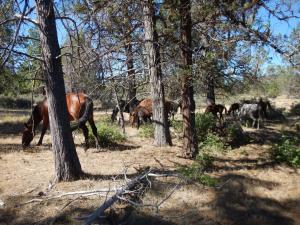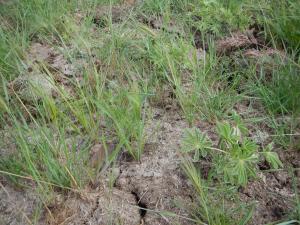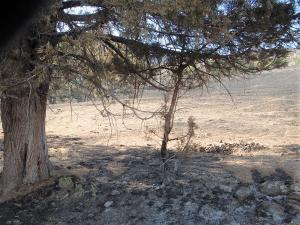Prescribed Burns - Are Not The Silver Bullet Suggested For Wildfires

“Quoting the author of the article below, “Most unfortunately, it seems that the most effective method for managing grass and brush wildfire fuels, using large bodied herbivores, is being overlooked in favor of methods that can be monetized”.
NOTE: this article was sent to us, and written by, Willian Simpson on January 5, 2022. It is published here with permission from the author.
Prescribed Burns – Are Not The Silver Bullet Suggested For Wildfires
Most unfortunately, it seems that the most effective method for managing grass and brush wildfire fuels, using large bodied herbivores, is being overlooked in favor of methods that can be monetized” — William E. Simpson II – Founder, Exec. Dir. Wild Horse Fire Brigade
YREKA, CA, US, January 8, 2023 /EINPresswire.com/ — There are people, NGOs and some elected officials who want to do prescribed burning across tens of millions of acres in America to reduce key wildfire fuels (grass and brush).
“Most unfortunately, it seems that the most effective method for managing grass and brush wildfire fuels, using large bodied herbivores, is being overlooked in favor of methods that can be monetized”, said William E. Simpson II.
By far, the most cost-effective method involves relocating taxpayer-owned American wild horses into wildfire prone remote critical wilderness areas.
The question stands:
Are some non-governmental organizations, as well as county and state elected officials going to continue selling American taxpayers the myth that:
Prescribed/Controlled/Cultura
Empirically speaking, the data we have prove that prescribed burning by any name is not only very costly, it’s led to some of the largest and most expensive wildfire disasters ever, killing wildlife by the millions, damaging soils and watersheds, and pouring more greenhouse gases into the atmosphere.
As we have already seen time and time again, ‘prescribed burning’, also known as ‘controlled burning’ is extremely dangerous, deadly and financially costly in many ways, even when used by highly-trained professionals supported by the best technology available today.
The most recent use of prescribed burning by professionals at the United States Forest Service (USFS) turned-disaster was experienced in New Mexico, where two prescribed burns went-wrong, joined together, and became the largest and most costly wildfire disaster in the history of New Mexico.
From the Washington post1:
“In a statement, the Forest Service said that what began as a controlled burn in the Santa Fe National Forest in January, meant to clear away vegetation and prevent catastrophic wildfires in the future, turned into a “sleeper fire.” It overwintered beneath the ground, continuing to burn slowly until it re-emerged in early April.
Fueled by strong, gusty winds, the Calf Canyon fire escaped firefighters’ attempts to contain it.
On April 22, it merged with the Hermits Peak fire, which also began as a prescribed burn set by the Forest Service that grew out of control. In the month since then, the combined blazes have destroyed hundreds of homes and displaced thousands of people.”
When it comes to ‘prescribed burning’, ‘controlled burning’ or as it’s now being rebranded as ‘Eco-Cultural Fire’ to confuse taxpayers into thinking it’s somehow safer fire, playing with fire, regardless of who’s doing it or where, results in disaster, time and time again.
An excerpt from a 2015 article from Outside Magazine2 titled, When Prescribed Burns Go Wrong, clearly shows that the disasters that stem from prescribed burning, are being repeated over and over, as are the evolving explanations and excuses for the disasters:
“Tom Scanlan’s house burned down on an early spring afternoon in March 2012. Just days before, the Colorado State Forest Service had set fire to the dangerously overgrown forest near the Lower North Fork of the Platte River, about 40 miles outside Denver. The controlled burn was supposed to stave off a future blaze; instead, warm temperatures and high winds fanned a wall of flames that torched 1,400 acres, left three people dead, and destroyed 23 homes—even those like Scanlan’s with defensible space. “They did a number of things wrong,” says the 69-year-old former aeronautics executive, “but the biggest thing was setting that fire in the first place.”
Each year, more people like Scanlan move into the so-called wildland-urban interface. Ten million new homes were built in these exurban areas between 2000 and 2010; over 30 percent of America’s housing stock is now in the WUI. That means a growing number of people risk evacuation, property loss, and death when these kinds of accidents occur.
In March of this year, high winds and temperatures rekindled an extinguished burn in Red Lodge, Montana, forcing 500 skiers off the local ski area; another burn, in Victorville, California, quickly exploded into a 70-acre wildfire that required evacuation of 25 houses. The fires aren’t always so small. In 2000, the prescribed Cerro Grande fire near Los Alamos, New Mexico, torched over 280 homes. While residents have sued government agencies over burns gone wild, it’s hard to prove negligence; it’s more common to receive a small payout through emergency funds. (Those affected by the North Fork fire that destroyed Scanlan’s home received approximately $18 million from the Colorado government.)”
There are many more examples of prescribed / controlled burns gone-wrong and causing death and costly disaster. It’s evident that any arguable benefits of these intentional fires is far outweighed by the adverse results of these prescribed burns.
Think about what is being sold, that; prescribed burning grass and brush fuels in the winter that didn’t get burned by a wildfire in the summer somehow makes the landscape safer.
The giant bug in that ointment is the fact that grass and brush are ‘annual fuels’, and come-back onto the landscape in full force by late spring – early summer and dry quickly and stay dry longer thanks to climate change.
So what, exactly is accomplished by winter prescribed burning?
The answer is; very little, other than spending boat-loads of tax dollars and risking more devastation being inflicted upon the people, homes, forests, wildlife, watersheds and climate change via adding greenhouse gases.
*The most important questions goes unasked; why?
It seems that there are people who are directly or indirectly monetizing annual wildfires who are not interested in asking the single most important question in regard to the evolution of wildfire.
Why now is the landscape suffering from over-abundant annually-occurring grass and brush wildfire fuels buildup?
The answer to this most-important question is not climate change, nor is it a lack of logging trees, which opens-up the canopy and stimulates the growth of under-story plants and grasses (wildfire fuels). And in remote wilderness areas suffering from a collapsed herbivory, the buildup of these grass and brush fuels is prodigious.
The answer and reason for the now massive buildups of annual grass and brush, which are the key fuels in over 60% of all wildfires, is that our native species herbivory has collapsed due to mismanagement. Prodigious grass and brush fuels that grow annually, even in spite of climate change, are the root cause of catastrophic wildfires.
There is an important tool being intentionally sequestered by some elected officials in favor of the lucrative enterprises related to wildfire suppression (aka: firefighting).
That tool is a Plan known as the Natural Wildfire Abatement and Forest Protection Plan3.
The winners from implementing this Plan include:
1. Timber Industry
2. Forest and wildlife enthusiasts
3. Fisheries
4. Hunting Industry (benefits all game animals)
5. Livestock Industry
6. Insurance Industry
7. Climate Change/Crises
This presentation about Wildfire & Wild Horses at the 2022 Mustang Summit (30-min. talk) outlines a Plan for reestablishing our native herbivory, which is our 1st-line tool for wildfire prevention:
https://www.youtube.com/watch
3-min. Primer on ABC NEWS story about the Natural Wildfire Abatement and Forest Protection Plan:
https://www.youtube.com/watch
*Are Wild Horses a ‘Native Species?
*Here’s what the world’s leading Equine Paleontologist (Dr. Ross MacPhee – Curator at the American Museum of Natural History) told the world at a transcribed lecture in New York: https://docs.google.com/docum
*The U.S. Ninth Circuit Court of Appeals in California recognized wild horses as native species, explaining that BLM “establishes Appropriate Management Levels (“AMLs”) for populations of native species – including wild horses, burros, and other wildlife – and introduced animals, such as livestock.” In Defense of Animals, et al. v. U.S. Dept. Interior, et al., No. 12-17804, *6 (9th Cir. May 12, 2014).”
Wild Horse Fire Brigade Org (and link-minded supporters) believe that existing wild horse management is flawed and exorbitantly costly due to law from 1971 that predated consumer-driven land-use demands, and is based upon science from the 1950-1960s that is now clearly obsolete and contradicts intelligent wild horse management.
Further, Wild Horse Fire Brigade Org believes that it is no-good for wild horses and livestock to remain commingled in areas virtually devoid of the natural predators of wild horses, and where wild horses are deemed to be in conflict with consumer-driven land-use demands. This is of paramount import given there is about 115-million acres of wildfire-prone remote critical wilderness where livestock production and motorized equipment/vehicles are prohibited by law.
And as such, horses should properly be humanely relocated to other available wilderness areas where they provide proven wildfire fuels management benefits to taxpayers and other stakeholders and where they will not be in conflict with land-use demands; relocated to wilderness areas that are both economically and ecologically appropriate, ending the problem.
Putting fire onto 12-million acres of public lands in California for instance, is not only prohibitively expensive and required virtually on an annual basis, it flied in the face of the logic of published peer-reviewed science:
1. Prescribed/Controlled/Cultura
2. Even low intensity wildfire (and prescribed/controlled/cultura
California’s current population of deer is collapsed and down approx. 3-million animals that were previously annually grazing approx. 3.6-million tons of annual grass and brush which remains on the landscape annually. Any fire in areas that are habitually overgrown and stocked with abnormally high levels of fuels will burn catastrophic hot, regardless of who is using applied fire in an attempt to reduce annual grass and brush fuels.
1) Low-severity wildfires impact soils more than previously believed; Desert Research Institute https://www.sciencedaily.com/
“Low-severity wildland fires and prescribed burns have long been presumed by scientists and resource managers to be harmless to soils, but this may not be the case, new research shows. According to two new studies, low-severity burns cause damage to soil structure and organic matter in ways that are not immediately apparent after a fire.”
‘High and low-temperature pyrolysis profiles describe volatile organic compound emissions from western US wildfire fuels’; https://www.researchgate.net/
2) After The Fires – Hydrophobic Soils. University of Idaho; https://www.uidaho.edu/-/medi
“Aside from property and aesthetic loss, this can include situations where highly erodible soils are exposed by burning the organic material on the soil surface. The burning of litter and organic material can reduce infiltration, increase surface runoff and erosion, and lead to hydrophobicity, or hydrophobic soils.”
3) Importance of maintaining cover crops in wilderness for ground water during drought.
‘Comparing infiltration rates in soils managed with conventional and alternative farming methods: A meta-analysis’; https://journals.plos.org/plo
“We found that introducing perennials (grasses, agroforestry, managed forestry) or cover crops led to the largest increases in infiltration rates (mean responses of 59.2 ± 20.9% and 34.8 ± 7.7%, respectively). Also, although the overall effect of no-till was non-significant (5.7 ± 9.7%), the practice led to increases in wetter climates and when combined with residue retention.”
William E. Simpson II has spent 8-years studying the behavioral ecology of wild horses, how they re-balance ecosystems and also, how they sequester carbon compounds into soils. Wild horses accomplish carbon sequestration while concurrently reseeding soils with the undigested seeds of native flora via their dung. This is a function that is not seen in ruminants that digests virtually all of the native flora seeds they consume. (See Images)
These proven facts support the critically important concept that wild horses are exceptionally equipped to naturally manage wildfire fuel loading (grass and brush), thus, maintaining the grass and brush preventing prodigious annual buildups, and reseeding the cover crops required for maximum infiltration of annual precipitation.
An additional function of that process is that wild horses engaged in wildfire grazing support the life-cycles of flora required by co-evolved fauna that are dependent upon the native flora for their sustenance. The co-evolved fauna requiring proper wilderness cover crops include game animals (mammals and birds) as well as insects / pollinators.
It’s settled-science that ruminants (deer, cattle, sheep, goats) digest virtually all of the seeds they consume, and therefore, end the life-cycles of plants and grasses that they use for forage. Wild horses do not, as is disclosed in several peer-reviewed published studies on the germinablity of seeds in horse dung.
*Horse dung germinable seed content in relation to plant species abundance, diet composition and seed characteristics; https://www.researchgate.net/
The loss of native cover crops is disastrous for critical wilderness areas and leads to the degradation of forests, watersheds and wildlife, since the net loss of native cover crops results in the decline of game animals (deer, elk, quail, grouse, chukar, pheasant, doves, etc.) (and non-game) and pollinators / insects.
The net loss of native cover crops in fire-stricken wilderness (and areas subjected to prescribed/controlled/cultura
The post fire erosion is devastating on fisheries as a result of sedimentaton of spawning beds for endangered salmonids and trout, and results in collapsed fisheries.
KRISWEB – Sediment In Streams; https://www.krisweb.com/strea
“Excess sediment can profoundly effect the productivity of a salmon or trout stream (Cordone and Kelly, 1961).
—————————–
Wild Horse Fire Brigade
+1 858-212-5762
email us here
Visit us on social media:
YouTube
Other
2 https://www.outsideonline.com
3 https://www.wildhorsefirebrig
![]()
—
For more posts like this, in your inbox weekly – sign up for the Restoring Diversity Newsletter






